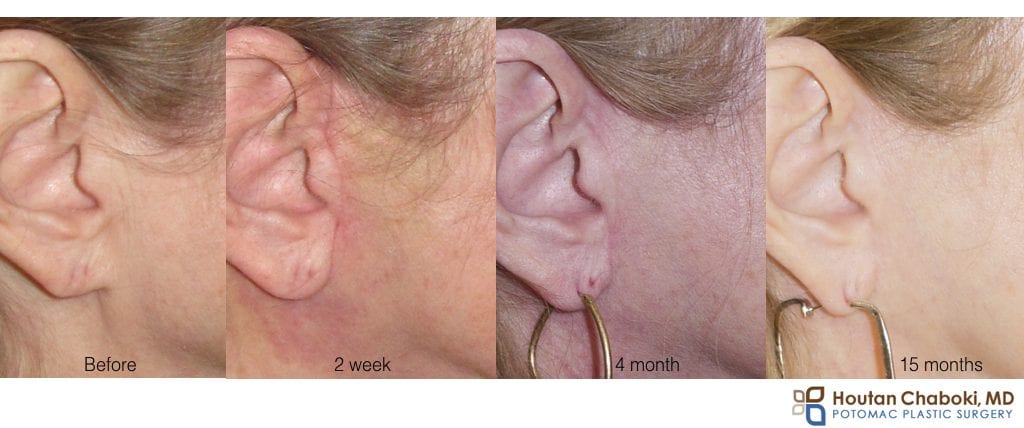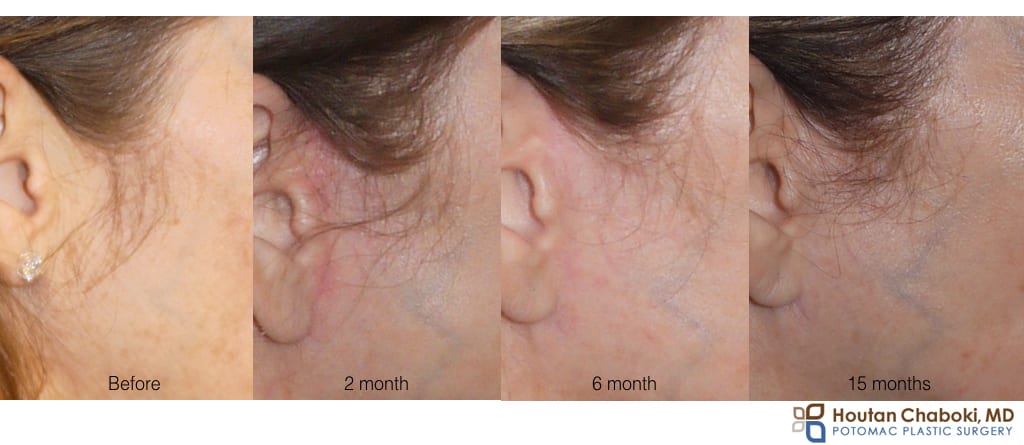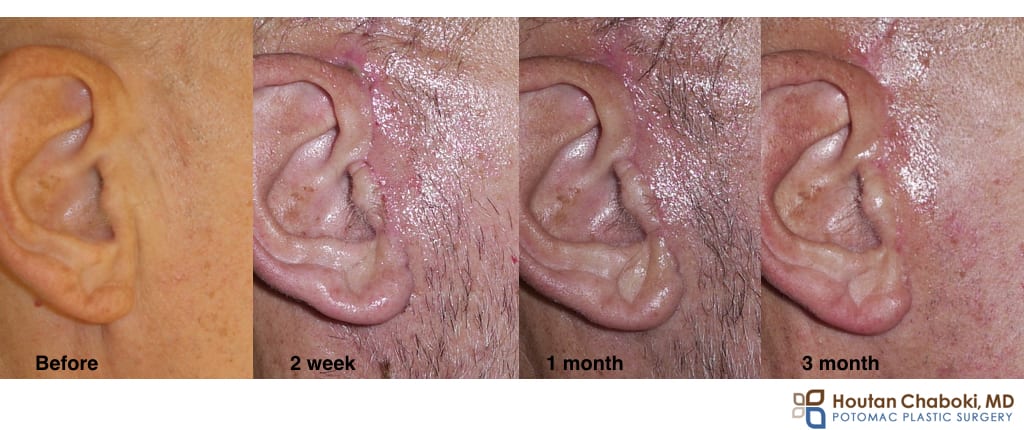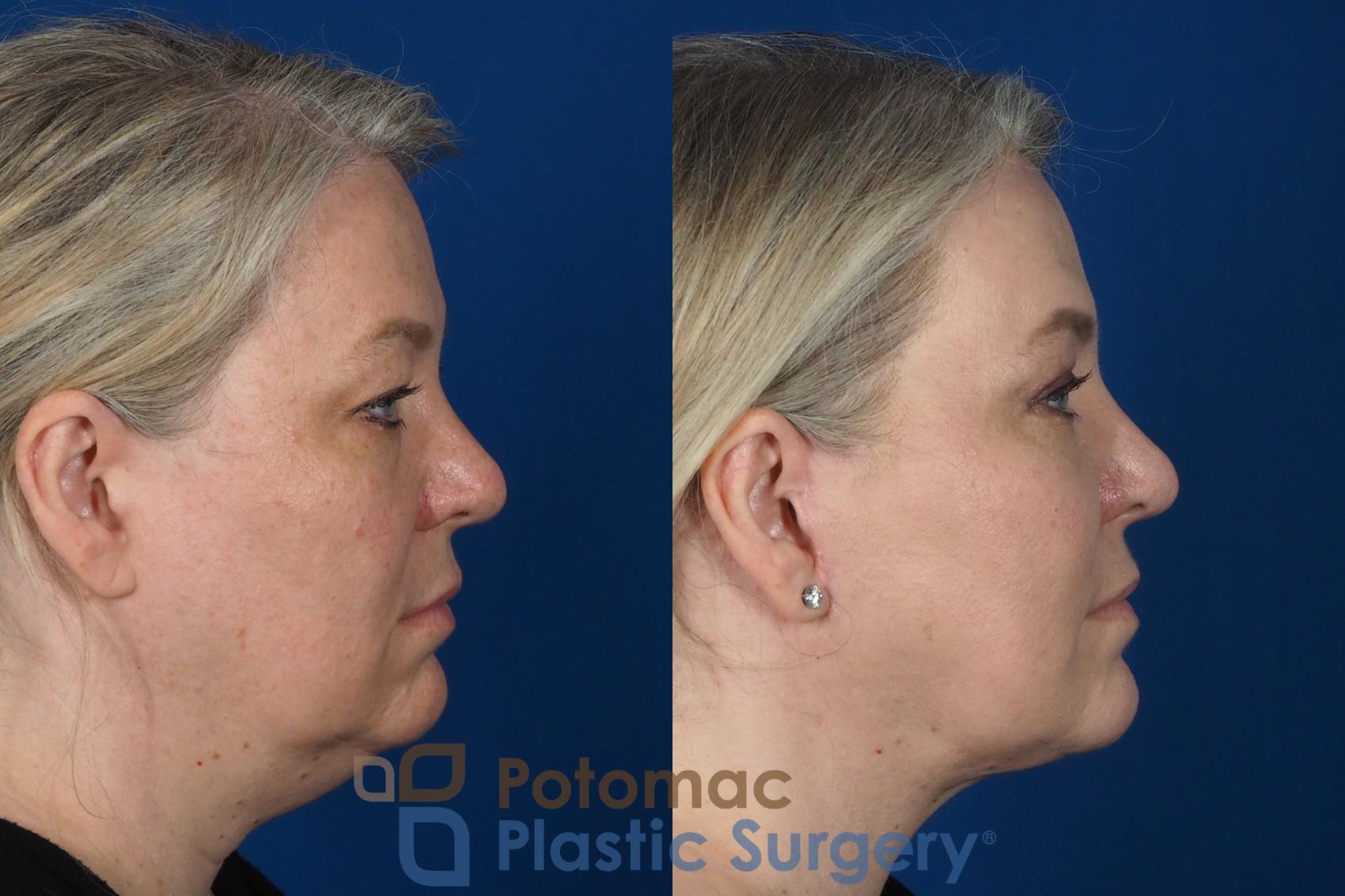If you’re considering a facelift, one common concern is how visible your incisions will be during and after recovery. At Potomac Plastic Surgery, we understand that the thought of scarring can be daunting. In this post, we’ll guide you through the healing process for facelift incisions, share tips for minimizing scars, and include real patient photos that show how incisions fade over time.
Facelift Options & Techniques
Plastic surgeons use various facelift techniques tailored to each patient’s specific needs, including the following:
- S-lift
- Mini Facelift
- Short Scar Lift
- MACS Lift
- SMAS Facelift
- Deep Plane Facelift
While these procedures may differ slightly in technique, the cosmetic results are generally similar, as all aim to create a balanced and natural look. Dr. Chaboki will recommend the most appropriate approach based on your goals, skin type, and facial structure.
Learn more about the facelift types we offer in our related blog post.
Face Lift Incisions
Regardless of the type of facelift your surgeon recommends, the face lift incision is usually similar. It may run from the temple and side burns, down around the ear, to the upper neck areas. The incision length and location vary based on how much lift an individual needs.
For this personalized lift, the plastic surgeon will attempt to minimize the incision but maximize the lift while maintaining a natural appearance. The best plastic surgeons will tailor a facelift to the needs of each patient rather than doing only one type of procedure.
Facelift incisions fade with time. – Houtan Chaboki, MD
Facelift Incision Healing Stages: What To Expect
Dr. Chaboki carefully places incisions to be as discreet as possible, and with proper care, they tend to fade significantly over time. Here’s a look at the phases of incision healing.Healing after a facelift progresses through 3 main stages, each with distinct characteristics. Here’s what you can expect at each phase:
- Early Phase (First Few Weeks): During this initial stage, incisions may appear swollen, red, tender, or bruised. Stitches are usually removed or dissolve within the first week. While incisions are more visible during this period, following post-op care instructions can help reduce irritation and support healing.
- Middle Phase (First Few Months): In this phase, incisions start to soften, flatten, and become less pink. Any residual tenderness generally fades. This is the period when scars begin to blend more naturally with your skin.
- Late Phase (Up to a Year): The final stage of healing involves scar maturation, which typically takes about a year. By this time, facelift scars are usually thin, white, and flat, blending smoothly with the surrounding skin. In many cases, they’re no longer directly visible, allowing for a very natural appearance.
Patient Tip: Healing is a gradual process. Taking progress photos each month can help you see the subtle but consistent improvements over time.
Healing Progress: Facelift Photos at 2, 6, and 15 Months
Below are close-up before and after photographs of one of Dr. Chaboki’s facelift patients that document healing progression at 2, 6, and 15 months post-op. As you can see, the incisions are well hidden even on close examination. Even in the earlier stages of face lift recovery, women can style their hair as they desire, including styles that sweep hair away from the face.
When Can I Use Makeup To Cover Facelift Incisions
Makeup is usually allowed after an appropriate healing period due to the risk of infection or skin irritation with premature makeup use. During the first weeks, only topical bland, non-allergic ointments such as petrolatum (such as Vaseline® or Aquaphor®) or silicone are normally allowed. Once the face and neck are in the middle phase of healing, then makeup can be applied to hide healing scars.
When Can I Shave Near My Facelift Incisions?
Similar to makeup, men must wait until appropriate healing has occurred before shaving near their facelift incisions. Most men can shave 2 weeks after plastic surgery.
Can Ointments Reduce Facelift Scarring?
In a previous blog post, we discussed ointments to help reduce scarring after plastic surgery. Be careful and always review care instructions with your facelift surgeon before using an ointment on your incision.
Research has demonstrated that some topical ointments, such as vitamin E, triple antibiotics, Neosporin®, or Bacitracin®, may cause a skin allergy or contact dermatitis after prolonged use. Other topical antibiotic ointments, such as polymyxin B or muporicin, have much lower risk of skin allergy.
- Avoid Smoking and Smoke Exposure: Smoking can restrict blood flow, slowing the healing process and leading to more noticeable scars. Even secondhand smoke can have adverse effects on healing.
- Protect from Sun Exposure: Direct sunlight can darken scars and prolong healing. Cover your incisions with scarves, hats, or clothing, and once the area is adequately healed, apply sunscreen daily to protect your skin.
- Use Ointments Wisely: Some topical treatments, such as silicone gel, can aid healing and reduce scarring. Be cautious with antibiotic ointments, as prolonged use may cause irritation. Dr. Chaboki will guide you in choosing safe products.
- Treat Infections Promptly: If you notice any signs of infection, such as redness, warmth, or discharge, contact Dr. Chaboki immediately. Quick treatment can prevent infection from worsening or affecting scar appearance.
- Massage the Scar Tissue: Once incisions are fully healed, gentle massage may help soften scar tissue and improve circulation in the area. Dr. Chaboki can recommend specific techniques for optimal results.
We advise patients to avoid getting incisions wet for the first few days and to use topical ointments, like petrolatum jelly or silicone gel, on the incision daily for approximately 2 months. These steps can help create a smoother healing experience and minimize the appearance of scars.
Final Results: Facelift Before and After
While the healing process is gradual, the final results are worth the wait. Below, you’ll see photos that capture the refreshed, natural look our patients achieve once healing is complete. Dr. Chaboki’s approach prioritizes subtle enhancements, leaving you looking revitalized without noticeable signs of surgery—achieving a lifted, youthful appearance that stands the test of time.
Take the Next Step
At Potomac Plastic Surgery, we’re committed to helping you achieve a rejuvenated, natural look with minimal visible scarring. Healing from a facelift is a process that requires patience, but rest assured, your incisions will continue to improve over time. By following post-surgical care instructions and practicing good scar management, you can enjoy long-lasting, beautifully natural results.
Contact the office today to discuss your concerns and discover whether facelift surgery is appropriate for you. You can use our online form to request a consultation or call us at (202) 800-2085.








Hi, I had facelift and neck lift with chin implant 3.5 weeks ago, incisions behind ear were done in a manner that after they were stitched up they were literally bunched, ruffled and a few folds, the Dr has told me to wait, but every time I look behind ears it looks the same to me. it almost looks like he just took all the excess skin and bunched it together and starting to sew. I am majorly concerned because I am active duty Army and have to wear my hair up in uniform and presently it’s impossible with the atrocity I have behind my ears. Also, my chin implant hurts, I think it has slightly moved. How can I confirm it’s still where it’s supposed to be?
Thank you for reading the blog and your military service!
Wearing hair up in a pony tail after a facelift or neck lift surgery is a common concern among facelift and neck lift patients. Our patients are generally putting their hair up soon after surgery. Many plastic surgeons will remove excess skin to avoid “bunching” of skin to variable degree. As with any procedure, patients should continue followup with their plastic surgeon to review concerns, especially in the early recovery period.
Best,
Dr. Chaboki
I had a facelift 3 years ago. I have scars in front of my ears that look like severe burns that spider webs in some aces 2 1/2 inches out from ear and this is excessive scarring. Have you seen such scarring like that before?
Hi,
We have not seen excess scarring with our facelift or neck lift patients. However, we have seen and treated patients who come specifically for their scars. Nonsurgical treatments with injections can help improve the appearance of facelift scars. If you haven’t already, you can speak with a plastic surgeon to help determine appropriate options.
Don
Best,
Dr. Chaboki